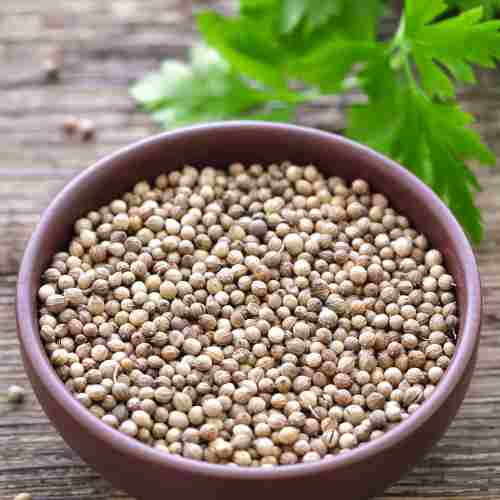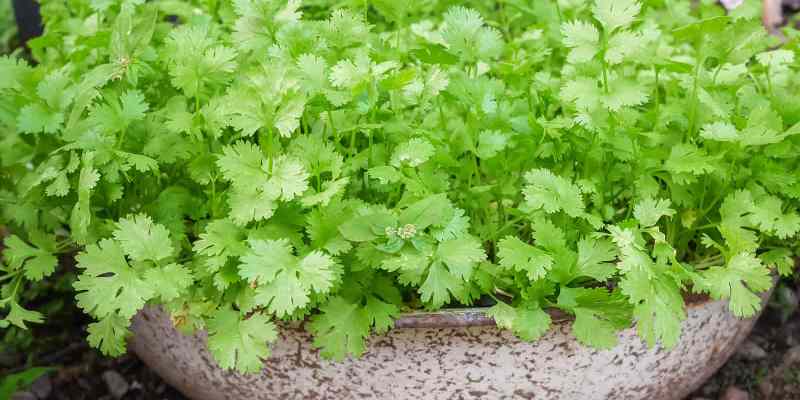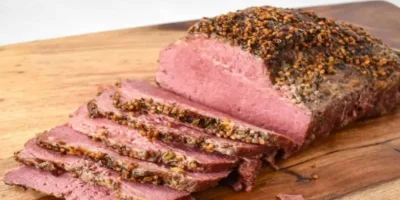Complete guide on how to grow cilantro outlines how to sow, care for and harvest cilantro leaves and seeds, plus culinary and medicinal uses for cilantro.
Find more garden guides, tips and advice
Find more food guides, tips and advice
Cilantro ( Coriandrum sativum ) is native to southern Europe and the Middle East. Because of its distinctive smell, it is also known as bug herb. Cilantro can also sometimes be purchased under its other name “coriander”. Like parsley, it belongs to the umbelliferae family. This culture guide for cilantro summarizes what is important for successful cultivation. We also give tips on how you can use cilantro in the kitchen or as a medicinal herb.
TABLE OF CONTENTS
Growing cilantro successfully
How to grow cilantro: Instructions for sowing
How to grow cilantro: Care tips
How to grow cilantro: Harvesting the leaves and seeds
An overview of all the important culture information for cilantro
Cilantro In the kitchen and as a remedy
Cilantro pests and diseases
How to grow cilantro in pots or the garden

Cilantro is an easy-care, annual plant that is also suitable for growing in tubs or large pots. It grows upright and can reach a height of 70 cm. The lower leaves grow tri-lobed, the upper leaves are finely pinnate. The flowers appear as umbels in the colors white to pink.
Instructions for sowing cilantro: how to grow cilantro from seeds
Cilantro can be sown indoors all year round. In the field, however, the seeds should only be put into the ground between April and September. Sunny, sheltered locations are ideal, as the stalks are not particularly strong and can quickly droop. The soil can be undemanding, but should drain well, as cilantro does not tolerate waterlogging.
The seeds of the cilantro are light germinators and should therefore be placed at a depth of only 0.5 cm. At temperatures between 12 and 22 ° C, cilantro needs 12 to 15 days to germinate. Later, the plants should be planted at a distance of 20 to 25 cm.
How to grow cilantro: Care tips
Since the stalks are not very strong, you should provide cilantro with a small support structure during the flowering period in high and late summer . When it is dry, flowering occurs faster, but fewer herbs are formed. For this reason you should absolutely avoid drying out the plants if you prefer to grow cilantro for harvesting the leaves. So water the cilantro regularly even in dry weather so that fresh leaves grow as long as possible. In late summer or autumn, however, dry cultivation has the advantage that the seeds develop more quickly.
Cilantro looks particularly good in a mixed herb border, surrounded by other plants. Here it can fill all possible gaps with its filigree foliage . Individual plants, on the other hand, can act like weeds.
How to grow cilantro: Harvesting the leaves and seeds
In the house, where cilantro can be cultivated all year round, a year-round harvest is also possible. In the field, the harvest period is from May to November. Both the leaves and the seeds are suitable for harvesting. The former have a pungent odor that can be described as a mixture of sage and lemon peel. Many people find it uncomfortable. By the way: even the roots of cilantro are edible and can therefore be harvested. But they taste much more intense. So dose the roots very carefully.
| Location | sunny, sheltered location; undemanding, but as permeable as possible soil | Coriander is undemanding, but does not tolerate waterlogging. |
|---|---|---|
| Sowing time | in the house: all year round Outdoor: April to September | In autumn the seeds ripen faster if the cultivation is dry. |
| Sowing depth | maximum 0.5 cm | Coriander is a light sprout, so just press the seeds down and cover them lightly with soil. |
| Plant spacing | 20 x 20 to 25 cm | It is best to plant coriander in dense clusters or in gaps, as it can act like weeds as a single plant. |
| Germination temperature | 12 to 22 ° C | The temperature should not be lower or higher, otherwise the germination process can stall. |
| Germination time | 12 to 15 days | Always keep the germ bed moist. |
| Harvest time | Outdoor: May-November in the house: all year round | The leaves and seeds are preferred. The roots are also edible, but have a much more intense aroma. |
Cilantro in the kitchen and as a remedy
Cilantro is particularly popular in Asian and Latin American cuisine. Its leaves are, for example, the main ingredient in Indian curry. In addition to the leaves, the seeds can also be used to flavor a wide variety of dishes. Both are very suitable for canning cucumbers, for sauces, as gingerbread spice or for refining Asian pans or wok dishes and stews. If you want to give your tea or coffee an individual touch, you can use the seeds for seasoning.
As a medicinal plant , cilantro in the form of an infusion is said to have a digestive effect, while cilantro oil is used in aromatherapy. Cilantro is also said to help with the smell of garlic.
How to grow cilantro: pest infestation and diseases
Even with great care and correct cultivation methods, cultivation problems such as plant diseases, pest infestation or nutrient deficiencies can arise when gardening. In order to thrive there properly, the herb needs a sunny location and loose soil. You can harvest your coriander after just a few weeks. So that possible problems can be identified quickly during the cultivation phase, we have put together a list of the most important and most common cultivation problems.
SOFT BUGS
Description:High temperatures and little moisture are ideal conditions for soft bugs to spread. An infestation can usually be detected from mid-May when there are white to yellow sucking spots on the leaf stalks and leaf veins of the coriander. These occur at uneven intervals and over time they initially turn red to brown and later even black. Then necroses also form (tissue that has died from cold, heat, toxins, radiation or metabolic disorders) and the affected areas dry out and break out. This creates holes in the leaves. In addition, there are growth delays and curvatures. The tissue of the plant turns dark green above the puncture sites. Later necrosis and wilting appear. The flowers and flower stalks of the coriander also show symptoms. They remain closed and are red to brown in color. Affected fruit systems develop necrosis in the places where the soft bugs stung them. Furthermore, no more fruits develop. There are bumps on the umbel and leaf stalks that break up over time. This means that pathogens can penetrate the coriander faster.
Prevention: Coriander should be placed in a place where there has not been any soft bug infestation. Check the existing weeds regularly. In addition, culture protection nets can be used.
Control: Preparations made from potash soap, pyrethrins, neem and rapeseed oil can be used against soft bugs . Neem should not be used before 10 p.m. during bee flight time. Ideally, treatment should be avoided during the flowering period.
JAPANESE BEETLE (POPILLIA JAPONICA)
Description: The Japanese beetle, originally from Asia, causes severe damage to cultivated and wild plants. The Japanese beetle is 8 to 12 mm long. The top of the wings appears metallic copper-colored, while the head and body shimmer gold-green. The Japanese beetle can be recognized by the white tufts of hair, five of which are small on each side of the abdomen and two larger ones on the end of the body. The Japanese beetle belongs to the scarab beetle family and is similar in appearance and biology to the June or garden beetle. There is therefore a risk of confusion. In contrast to the Japanese beetle, this one does not have the typical white tufts of hair.
The grubs live in the soil of moist meadows and feed primarily on grass and herb roots. This can mean significant damage to lawns or herbs. After the larvae pupate, the adult Japanese beetles hatch between May and June. The main flight time of the Japanese beetles is between mid-May and mid-August. Adult beetles eat the leaves of the plant – sometimes down to the branches, so that leaf skeletons (skeletal damage) can arise. Affected parts of the plant turn brown and can fall off. If a plant has flowers, these are also not protected from additional traces of feeding by the beetle. Interestingly, it can be observed that they seem to devour individual plants completely, while neighboring plants show hardly any damage.
Prevention: Mechanical tillage should be done in early autumn. This reduces the chance of survival of larvae that eat close to the ground. These larvae should be recorded as part of this processing. Avoid watering grass areas during the main flight time, as this makes it less attractive for the females to lay eggs. Furthermore, a higher cutting height can counteract the spread and reproduction of the Japanese beetle. You can visually monitor host plants and the surrounding soil. If you discover an infestation, it should be reported to the responsible plant protection service (see section “Control”).
Control: Various beneficial insects such as birds, moles, shrews, rock wasps and ground beetles eat the larvae in the ground. Bacteria ( Paenibacillus popilliae ), parasitic nematodes (including Steinernema sp , Heterorhabditis sp. ) Or entomopathogenic fungi ( Beauveria bassiana , Metarhizium anisopliae ) can also be used against the larvae . Small accumulations of beetles can be fought with attractant traps (pheromones) and mechanical collection.
Since it is essential to avoid spreading in Europe, if there is a suspicion of an infestation with the Japanese beetle, it should be caught (e.g. in a jar) and the responsible plant protection service informed.
RED WILT, FUSARIUM WILT
Description: A high level of humidity promotes the spread of the fungus. Previously it survived in the mycelium as chlamydospores or saprophytic (feeding on dead organic substances) in the soil, but now it penetrates the coriander. There it occupies the pathways of the roots and forms its mycelium again. In addition, this releases toxic substances, so that the coriander can no longer defend itself against the infestation.
Spore beds that appear cushion-shaped and contain conidia develop on dead plant parts. These are distributed with the help of water, tools, wind or contaminated soil. The red wilt occurs first on older plants. Their leaves show chlorosison and partly the plant turns red and withers. In contrast, the rest of the plant still looks healthy and retains its green color.
A gray-black discoloration develops at the base of the stem, which spreads upwards along the stem. In addition, the topmost plant skin tears. The affected parts of the coriander die off over time. A white blanket of mycelium and spore beds forms over them. Over time, it turns pink to orange. The vascular bundles are also red to brown in color. Root rot can also break out.
Prevention: A large distance between the plants helps, as this way the stand is well ventilated. The use of potash fertilizers is advantageous and should be preferred to nitrogen fertilizers. If possible, the pH of the soil should be above 7.
Control: Diseased plants must be removed.
YELLOW WILT, RAMULARIOSIS
Description: The fungus finds optimal conditions at temperatures between 13 and 20 ° C. But damp leaves also favor infestation. In the form of a mycelium , the pathogen persists on old parts of the plant until it can infect new plants. The spores of the fungus are distributed with the help of wind and water and germinate on the leaves of the coriander. This allows them to penetrate the plant tissue. There are conidia carriers (Spore carriers), which then grow through the upper plant skin.
These conidia carriers can be recognized by their white to gray color. They serve to spread the disease. The yellow wilt causes brown spots with different shapes to appear on the stems of the coriander. They have sunk in and have a crust. The upper parts of the stems bend like a hook. Over time, the stems and umbels become more and more brown and necrotic (dead).
During the shoot phase, brown-red spots also form on the leaves of the plant before they turn yellow and wither. In addition, there are white dots on the brown parts of the plant, which are arranged in a line and stand out slightly from the surface.
Prevention: Sufficient planting distance is important so that the air can circulate sufficiently and there is no moisture. Also a growing break of at least four years and an appropriate crop rotation are recommended.
Control: No control measures are available for the house and allotment gardens.
POWDERY MILDEW ( ERYSIPHE HERACLEI )
Description: Dry and especially warm weather periods are ideal conditions for powdery mildew to develop. The pathogen settles on old parts of the plant and thus survives the winter. With the help of wind, the conidia spread . On the upper side of the leaves a white mycelium develops , in which there are oidia (spores) including oidia carriers and chasmothecia . The latter can be seen in the form of black tiny spots.
Prevention: The infestation can be reduced through regular and sufficient irrigation.
Control: With the help of watering, the oidia can be damaged, making the disease more difficult to spread. In addition, the use of fungicides against acute infestation is advisable, but not always necessary.
BACTERIAL CONE BLIGHT / BACTERIAL LEAF SPOTS
Description: The cilantro is mostly infected via wounds through which the pathogen can get into the plant. There he then makes changes in the tissue. With the help of water splashes, tools and wind, this spreads. Hibernation takes place on old parts of the plant or in the ground. Depending on the time of infection, the symptoms of cone blight vary. This can lead to discoloration of the leaves at a very early stage. These are reminiscent of grease stains and are dark blue to green in color.
Over time, these develop into brown necrosis. In addition, there are yellowish-brown lesions on the stems of the coriander during the womb phase. The spots are clearly delineated from the rest of the healthy tissue. In the case of the cone brandy, the inflorescences of the coriander brown and necrosis occurs (tissue that has died from cold, heat, poisons, radiation or metabolic disorders).
At the beginning of the infestation and during wet weather periods, wet rot forms on the umbels and flowers. This creates slime on the affected parts of the plant. After the umbels and flowers have dried off again, they appear dried up and colored black.
The diseased tissue is also clearly visible from the healthy tissue. If the disease does not break out until after flowering, the fruits also show stunting. In addition, sunken spots appear on the underside of the leaves. These are arranged irregularly and have a watery, dark green to brown color. Red-brown necroses and brown spots appear on the top, whose center is lightened. If you hold the sheet up to light, you can see a watery border around the spots. If the infestation is very severe, the leaves turn yellow over time and die.
Prevention: There should be no other umbelliferous plants in the vicinity. These include, for example, the lovage and the cilantro itself. That is why it is also important to comply with cultivation breaks and crop rotations. Cilantro must be treated with care so that the bacteria do not find any wounds to enter. In addition, you shouldn’t water it too much.
 Genevieve Dumas is a design, fashion, food and style writer who has worked on major magazines and mastheads in the United States and Europe.
Genevieve Dumas is a design, fashion, food and style writer who has worked on major magazines and mastheads in the United States and Europe.




